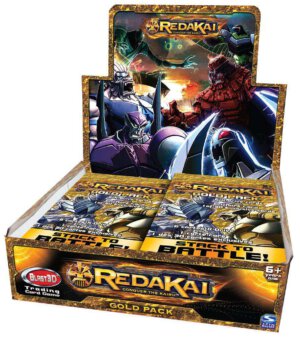
Publisher: Spin Master
Designer: Justin Gary
Year: 2011
Players: Two players
Ages: 6+
Playing Time: 20 Minutes
Genre: Collectible card game
MSRP: $29.99
Talk about a difficult review. I’m covering not only a game, but an entire line of game accessories, an animated series, and an entire franchise that has emerged in the past several months. I’m just going to concentrate on the game, and touch on the accessories in the Championship Tin set.
The fact that many of the cards are clear plastic, similar to the way Gloom from Atlas Games works, means that the attacks can be stacked on top of the characters to show them receiving damage, and other stacking effects can be piled up as well.
The animated series, the story, and the card game are based upon the use of the mystical power of Kairu which has been scattered all over the Earth. The three heroes, Ky, Maya, and Boomer are trying to reclaim the Kairu, but are of course besieged with various bad guys. It is a Japanese animation style similar to Yu-Gi-Oh and Pokemon. If you or more likely your children are into those games you will probably enjoy Redakai.
The Championship Tin comes with a full deck of 40 cards and three character cards, which is enough for one player. To actually play against someone you will need at least two decks. You will need to select three character cards which will make up your attacking force during the battle. The Tin only comes three character cards so your initial choice is limited, but you can always get more.
The mechanics of the game are very simple. Redakai is aimed at the pre-teen crowd and the suggested age of 6+ is possible, but probably more like 7 or 8. Each character card has three damage marks on the top right corner. A
Along the left side of the card are three defense zones. Attacks come in three flavors: red, green and blue. The defense zones can provide partial protection from the different attacks. If you have 300 red defense in one of your zones, then it will take a red attack with power greater than 300 in order for it to succeed. Of course, you are still vulnerable to blue and green attacks.
After selecting their three character cards, players shuffle their deck of forty cards and draw three of them. Players also start with three Kairu (energy), and this increases by one each turn. You need to spend Kairu in order to play cards and launch attacks.
Attack cards have a nice 3D attack graphic printed on them. You play them onto one of your opponent’s characters. It overlays the character card and will cause one or two marks of damage.
There are also monster cards, which is a sort of power up that you play on your own characters. They give you additional defenses and in some cases can heal wounds you’ve received.
Finally, many of the cards have REACT abilities. These can be played in reaction to an attack and can come in handy defending your characters. Each player takes turns, drawing a new card each turn, and flinging attacks on each other’s characters until one side or the other is eliminated. The surviving player wins.
The Championship Tin comes with a few extras that you really come in handy. There is a three slot tray to place your characters in, and it will stack all the cards played on them well. Also included is a card stand that holds the cards in your hand and blocks the other player from seeing what you have. This is pretty crucial as the cards are transparent. The card stand also has a track for your Kairu each turn. There are two clip-on coin pieces that you move back and forth along the Kairu track for this purpose.
The accessories are actually pretty crucial to gameplay, mostly designed to manage the card transparency issues, so if you are jumping into Redakai, I do recommend at least this minimum set.
The game is as I mentioned, pretty simplistic. There is not a lot of strategy involved, it’s mostly the luck of the draw. The end game usually involves waiting to see which player draws the attack card that will cause the right damage to kill off the other’s last character. I suppose that if you purchase enough cards you could build a strategic deck, and I’m sure that is why it is a CCG.
I can’t deny that it was fun. I had a good time playing Redakai. It’s easy to learn for you and the kids, the games are short, and the cards are cool. So yeah, I’ll admit I enjoyed myself. If only I still had Cartoon Network so I could watch the show, sigh.
One thing I neglected to mention about the cards. Many of them have three micro-glyphs imprinted in the lower right corner of the cards. These glyphs are actually animation cells that can be played in sequence rapidly in order to display a quick animation of the attack you are launching. You need a special accessory called the Animation Unit in order to see this effect. The unit has three LED lights in it that will reveal the animation when a card is inserted into its side. It’s nothing spectacular but it is cool.
Overall, Redakai is a nice addition to the realm of Anime collectible card games.
[rwp-review id=”0″]
- A Dungeon Delve for Kids?: A Review of Dungeon! - Oct 24, 2022
- Better, Stronger, Faster | Descent: Journeys in the Dark Second Edition Reviewed - Oct 23, 2022
- Your Planet is Doomed!: Invasion from Outer Space Reviewed - Oct 22, 2022